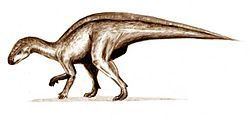Kingdom Animalia Clade Dinosauria Suborder †Ornithopoda Scientific name Rhabdodontidae Rank Family | Phylum Chordata Order †Ornithischia Clade †Iguanodontia Higher classification Ornithopod | |
 | ||
Similar Dinosaur, Ornithopod, Zalmoxes, Mochlodon, Rhabdodon | ||
Rhabdodontids were herbivorous ornithopod dinosaurs from the Cretaceous Period. Rhabdodontids were similar to large, robust "hypsilophodonts", with deep skulls and jaws. The family was first proposed by David B. Weishampel and colleagues in 2002. The rhabdodontids were defined as "the most recent common ancestor of Zalmoxes robustus and Rhabdodon priscus and all the descendants of this common ancestor". In 2005, Paul Sereno defined the family as "the most inclusive clade containing Rhabdodon priscus but not Parasaurolophus walkeri". The Rhabdodontidae includes the type genus Rhabdodon, Zalmoxes, Mochlodon and possibly Muttaburrasaurus. Rhabdodontid fossils have been found in Europe and Australia in formations dating from the Early to Late Cretaceous, 100 to 66 million years ago. Ősi et al. (2012) proposed that Rhabdodon underwent gigantism on the mainland, as opposed to Zalmoxes and Mochlodon experiencing nanism on island habitats. In 2013, Darren Naish discovered a tiny rhabdodont tibia from Sebeș, Romania, turning out to be the smallest known; a paper (Brusette et al 2013.) later in the same year identified it as Zalmoxes, cf. Z. shqiperorum.
Contents
ClassificationEdit
The Rhabdodontidae are a group of ornithopod dinosaurs, more specifically some of the basalmost iguanodonts. Most analyses find them to be more derived than Tenontosaurus but more basal then Elasmaria, Dryosauridae, Camptosaurus, and more advanced Iguanodonts.
There are differing opinions as to the constituents of Rhabdodontidae. The original definition, the last common ancestor of Zalmoxes robustus and Rhabdodon priscus, would not include Muttaburrasaurus. The definition by Sereno, the most inclusive clade containing Rhabdodon priscus but not Parasaurolophus walkeri, would include the entire ghost lineage, and Muttaburrasaurus. This ghost lineage lasts 90 million years without Muttaburrasaurus.
Most phylogenetic analyses recover Zalmoxes and Mochlodon to be sister taxa, with Rhabdodon as the sister taxon to that (Ősi et al. 2012; McDonald 2012a). Multiple analyses also find Muttaburrasaurus to be the sister taxon to all other rhabdodontids, including McDonald (2012a), and McDonald et al. (2010). The left genus-level cladogram is from an analysis by McDonald et al. (2010), including all possible rhabdodontids: The right cladogram shows a Rhabdodontidae not including Mochlodon, found by McDonald (2012a):
The left cladogram is from Ösi et al. (2012) and excludes Muttaburrasaurus from Rhabdodontidae: The right cladogram is from Weishampel et al. (2003) and excludes Mochlodon and Muttaburrasaurus from Rhabdodontidae:
List of known RhabdodontidsEdit
The below list includes all currently known rhabdodontids, and follows McDonald et al. (2010):
Note that undetermined Rhabdodon material from France and the Czech Republic respectively, currently referred to as R. sp., have on occasion been suggested to be distinct species. However, the Czech material has also been suggested not to be diagnosible to Rhabdodon specifically, and if found to be a new species, it may belong in a separate genus.
